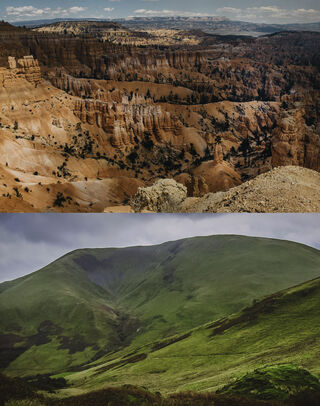Gaslighting
The Invention of Color
Part 1 of a 3-part series about the history of color.
Posted October 6, 2020 Reviewed by Devon Frye

Color is everywhere. It’s in our clothes, on our walls, and on our computer screens. We’re used to seeing thousands of colors every day, in a wide-ranging palette. For most of us, it seems no more remarkable to see an orange traffic cone than a blooming red rose.
Yet, such visual wonders were not always the norm. For much of human history, access to color was much more limited. In fact, I’d go so far as to say that color is a remarkably modern invention. Or at least, color as we know it.
The Natural Boundaries of Color in the Premodern World
In a world before automobiles, trains, and reliable road networks, most people lived local and rural lives. Their worlds would have been the colors of the landscape around them.
Someone living in coastal Wales would have seen the green of the hills, the blue of the sky, and the gray of the sea. That blanket of green would have been occasionally punctuated by pink or yellow wildflowers, but those colors were the rare treats of spring. Indigo and purple were the color of the sky at nighttime, but they would have been rare and fleeting in the material world.
Meanwhile, for a Shoshone person living in Utah, the colors of the world would have been red, orange, gold, and brown. Green was rare, appearing in scattered wisps of scrubs and brush, but there were no rolling hills and fields of flowers. The colors familiar to a Welshman would have been wholly foreign to someone from Utah, and vice versa.
Color was seasonal. In Norway, green was rare in winter, and in Germany, yellow was the color of autumn leaves. Likewise, color was bound by natural light. Without electricity or gaslight, there was no way to keep life vibrant after the sun set.
Color was also remarkably hard to lock into place. Many plant dyes faded in a matter of hours or days when they were exposed to sunlight. Most people had drab clothing, and the walls of their homes were the color of mud, wood, or stone. The natural world may have offered color, but the palette was subject to a number of constraints.
The Rarity of Colors
From time to time, someone would set out on a trading journey, crossing the sea or steppes in search of exotic goods for the few Europeans who could afford them. For the most part, though, the world that a person was born into was the world in which they would die.
Like ours, these worlds were full of laughter, love, and the ache of hard work; they were full of friendships, the sounds of animals, and the smell of tilled earth. But they were not filled with color—at least not in the way that our world is.
When bright colors could be captured, they were rare and, as a result, extremely expensive. Tyrian purple, for example, was a notoriously scarce color derived from the glands of Murex sea snails. It took twelve thousand snails to produce 1.4 grams of pure Tyrian purple, a quantity that would only have dyed the trim of one garment (Jacoby, 210).
Color meant money. It meant power. And it was exceedingly conspicuous. Before the eighteenth century, most people tended to live at the edge of subsistence. Few people would have had the means to even consider purchasing these colors. Art was a luxury, and if common people had the chance to see a painting, it would have been in their local church, not in their own homes.
Sumptuary Laws
Even if a person had money, though, that didn’t necessarily mean that they could buy whatever colors they wanted. Strict regulations called “sumptuary laws” dictated what people, including nobles, could buy, eat, and wear.
In ancient Rome, anyone who made Tyrian purple dye without permission could be put to death, and in the first century, Nero decreed that only the emperor could wear the coveted purple garments (Bucklow, 31).
Sumptuary laws weren’t only a feature of the ancient world. For example, in 1673, the French king Louis XIV proclaimed that only the highest nobles could wear his favorite accessory: shoes with dramatic red heels. This flash of color indicated that nobles were “always ready to crush the enemies of the state at their feet” (Mansel, 15).
Sumptuary laws protected traditional social hierarchies and made sure that everyone stayed in their place. Color was an instant marker of a person’s status, and at a glance, people could identify someone else’s social status, just by the redness of their heels or the drabness of their tunic.
Color wasn’t something that people chose freely, based on personal preference or mood. It was highly symbolic, and it had stable, coherent values. For better or worse, color offered a quick way to judge where someone fell in the pecking order.
Remarkable Colors
A series of technological, cultural, and economic revolutions that took place in the eighteenth and nineteenth centuries ushered in an entirely different color world. Color was no longer bound by laws, money, or nature. Those revolutions will be the subject of my next post.
For now, though, take a look around you. Notice the colors that adorn your books, walls, art, clothing, and other household objects. It’s hard to imagine a world without such a vivid array of options; a world where vivid hues were a precious, rare sight.
Today, we think of color as something readily available, accessible to all. But in order for that to happen, people had to figure out how to harness specific wavelengths of light and give them substance. That is nothing short of remarkable.
Facebook/LinkedIn image: Rohappy/Shutterstock
References
Bucklow, Spike. The Alchemy of Paint: Art, Science, and Secrets from the Middle Ages. London: Marion Boyars Publishers, 2009.
Jacoby, David. “Silk Economics and Cross-Cultural Artistic Interaction: Byzantium, the Muslim World, and the Christian West,” Dumbarton Oaks Papers 58 (2004): 197-240). http://www.jstor.org/stable/3591386
Mansel, Philip. Dressed to Rule: Royal and Court Costume from Louis XIV to Elizabeth II. New Haven: Yale University Press, 2005.




